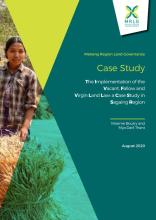Land Library Search
Through our robust search engine, you can search for any item of the over 73,000 highly curated resources in the Land Library.
If you would like to find an overview of what is possible, feel free to peruse the Search Guide.
/ library resources
Showing items 1 through 9 of 39.Данное техническое руководство, подготовленное совместно секретариатами Продовольственной и сельскохозяйственной организации Объединенных Наций (ФАО) и Конвенции Организации Объединенных Наций по борьбе с опустыниванием (КБОООН) при участии многих заинтересованных сторон, посвящено интеграции Доб
This Case Study looks at the implementation of the Vacant, Fallow and Virgin Lands Management Law (VFV Law) in seven villages in Sagaing Region, to assess the practices on the ground and how the law impacts the land tenure security of smallholder farmers.
Ce Profil national genre des secteurs de l’agriculture et du développement rural a été préparé dans le cadre du projet de coopération technique de la FAO et de la Commission de la CEDEAO portant sur : « la Réponse Genre aux Plans Régionaux et Nationaux d’Investissement Agricole pour relever le dé
Augmenter l'utilisation des Directives volontaires pour la gouvernance responsable des régimes fonciers (DVGF) parmi les organisations de la société civile et de base – Mali est une fiche d'information sur le pays qui fournit des informations sur le projet «Augmenter l'utilisation des DVGF parmi
The Mekong Region Land Governance (MRLG) project, MLIKE (Mekong Land Information and Knowledge Exchange), and the Land Portal co-facilitated an online dialogue on “Responsible Large Scale Agricultural Investments in the Mekong Region” on 09-27 October 2017.
In the Mekong region, conflicts between local communities and large scale land concessions are widespread. They are often difficult to solve.
Rubber prices in northern Laos have fallen significantly over the last few years, eroding much of the initial enthusiasm of both farmers and government officials about rubber providing a way out of poverty for poor upland farmers.
This dialogue provided a way for the land community to collaboratively explore challenges and opportunities related to the recognition of indigenous, ethnic minority and customary tenure rights in the Mekong region in order to:








